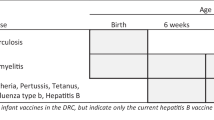Abstract
This was a prospective randomized cohort study to assess the effectiveness of an educational immunization intervention with pregnant Latinas on timely initiation of infant immunization. Study participants were recruited from two community clinics in north San Diego County. A total of three hundred and fifty-two Latinas in the third trimester of pregnancy were recruited and randomly assigned to intervention or control groups. Participants received either a culturally and linguistically appropriate session on infant immunization (intervention) or a session on prevention of Sudden Infant Death Syndrome (control). The main outcome measures were pre-post immunization knowledge change and infant immunization status at 92 days. Immunization knowledge increased significantly in the intervention group [p < .0001, 95%CI (1.76, 2.47)]. No difference was found between groups in immunization series initiation: 95 percent of the children in the intervention group were up-to-date by 92 days from birth, and 93 percent of the control group was up-to-date at 92 days. The lack of significant association between receiving immunization education and infant immunization series initiation suggests that parent education may be necessary but not sufficient for timely immunization, particularly in clinics with effective well-child programs. Given the significant increase in immunization knowledge, the broader and perhaps more important implication is that language- and culturally specific infant health education messages in the prenatal period may have a positive long-term impact on the child's health and promote well-child care overall. Future studies should assess the role of prenatal well-child education in the context of clinics with low immunization levels
Similar content being viewed by others
REFERENCES
Prislin R, Dyer J, Blakely CH, Johnson CD. Immunization status and sociodemographic characteristics: The mediating role of beliefs, attitudes, and perceived control. Am J Public Health 1995; 88:1821–1826.
Dales LG, Kizer KW, Rutherford GW, Pertowski CA, Waterman SH, Woodford G. Measles epidemic from failure to immunize. West J Med 1993;159:455–464.
Gindler JS, Atkinson AL, Markowitz LE, Hutchins SS. Epidemiology of measles in the United States in 1989 and 1990. Pediatr Infect Dis J 1992; 11:841–846.
Hinman AR. What will it take to fully protect all American children with vaccines? Am J Dis Child 1991; 145:559–562.
Moor P, Hepworth JT. Use of perinatal and infant health services by Mexican-American Medicaid enrollees. JAMA 1994; 272:297–304.
Centers for Disease Control and Prevention (CDC). Vaccination coverage by race/ethnicity and poverty level among children aged 19–35 months—United States, 1997. MMWR 1998a; 47:956–959.
California Department of Health Services. Kindergarten Retrospective Survey. Sacramento, CA; 1996.
US Department of Health and Human Services. Healthy People 2010 (Conference Edition, in Two Volumes). Washington, DC: January 2000.
State of California, Department of Finance. Race/Ethnic Population Estimates: Components of Change for California/Counties, April 1990 to July 1999. Sacramento, CA: June 2001.
Beck E. “Patient Education.” Introduction to Clinical Skills: a patient-centered textbook. In MB Mengel and SA Fields (Eds.), New York: Plenum Medical Books, 1997, pp 201–216.
Stevens VJ, Severson H, Lichtenstein E, Little SJ, Leben J. Making the most of teachable moments: A smokeless-tobacco cessation intervention in the dental office. Am J Public Health 1995; 85:231–235.
Fabiano P. Peer-based HIV risk assessment: A step-by-step guide through the teachable moment. J Am Coll Health 1993; 41:297–299.
Zola J. Obstetricians willing to educate about Hepatitis B vaccination. Provider Update (Publication of the San Francisco Department of Public Health) 1995; 3:1.
Lieu TA, Black SB, Ray P, Chellino M, Shinefield HR, Adler N. Risk factors for delayed immunization among children in an HMO. Am J Public Health 1994; 84:1621–1625.
Hutchins SS, Gindler JS, Atkinson WL, Mihalek E, Ewert D, Lebaron CE, Swint EB, Hadler SC. Preschool children at high risk for Measles: Opportunities to vaccinate. Am J Public Health 1993; 83:862–867.
Wood D, Donald-Sherbourne C, Halfon N, et al. Factors related to immunization status among inner-city Latino and African-American preschoolers. Pediatrics 1995a; 96:295–301.
Waterman SH, Hill LL, Robyn B, et al. A model immunization demonstration for preschoolers in an inner-city barrio, San Diego, California, 1992–1994. Am J Prev Med 1996; 12:8–13.
Lannon C, Brack V, Stuart J, et al. What mothers say about why poor children fall behind on immunizations. Arch Pediatr Adolesc Med 1995; 149:1070–1075.
Fielding JE, Cumberland WG, Pettitt L. Immunization status of children of employees in a large corporation. JAMA 1994; 271:525–530.
Leversha A, Kupfer D, Gaudino J, Brown P. Risk and protective factors for the underimmunization of children from birth to two years: A comprehensive literature review. Abstract presented at the National Immunization Conference, Detroit, Michigan; 1997.
Bates AS, Wolinsky FD. Personal, financial, and structural barriers to immunization in socioeconomically disadvantaged urban children. Pediatrics 1988; 101:591–596.
Griffin MR, Daugherty J, Reed GW, et al. Immunization coverage among infants enrolled in the Tennessee Medicaid Program. Arch Pediatr Adolesc Med 1995; 149:559–564.
Williams IT, Milton JD, Farrell JB, Graham NMH. Interaction of socioeconomic status and provider practices as predictors of immunization coverage in Virginia children. Pediatrics 1995; 96: 439–446.
Suarez L, Simpson DM, Smith DR. The Impact of public assistance factors on the immunization levels of children younger than 2 years. Am J Public Health 1997; 87:845–848.
Cuellar I, Arnold B, Maldonado R. Acculturation rating scale for Mexican American-II: A revision of the original ARMSA Scale. Hispanic J Behav Sci 1995; 17:275–304.
Centers for Disease Control and Prevention (CDC). Guidelines for Assessing Vaccination Levels of the 2-year-old Population in a Clinic Setting. US Department of Health and Human Services, Public Health Service; 1995.
Waller CS, Zollinger TW, Saywell RW JR, Kubisty KD. The Indiana Prenatal Substance Use Prevention Program: its impact on smoking cessation among high-risk pregnant women. Indiana Med 1996; 89:184–187.
Browner CH, Prelaoran M, Press NA. The Effects of ethnicity, education and an informational video on pregnant women's knowledge and decisions about prenatal diagnostic screening test. Patient Ed Counsel 1996; 27:135–146.
Author information
Authors and Affiliations
Rights and permissions
About this article
Cite this article
de Nuncio, M.L.Z., Nader, P.R., Sawyer, M.H. et al. A Prenatal Intervention Study to Improve Timeliness of Immunization Initiation in Latino Infants. Journal of Community Health 28, 151–165 (2003). https://doi.org/10.1023/A:1022651631448
Issue Date:
DOI: https://doi.org/10.1023/A:1022651631448




